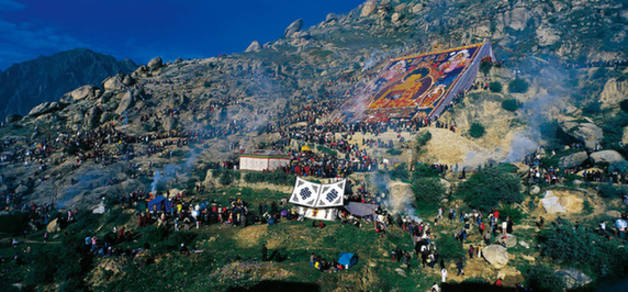| Shoton Festival
By staff reporter JIAO FENG
|

|
| Sunning the Buddha. CFP | PERCHED at 3,650 meters above sea level, Lhasa, capital of Tibet Autonomous Region (TAR), is among the highest cities on earth. In Tibetan the name means "holy land," and this is true to its function: the city is the heart of Tibetan politics, economy, culture and religion. The landmark Potala Palace overlooking the city is the emblem of theocratic rule that held sway in the region until 1951.
Tibet first appeared on the Chinese map back in the 13th century during the Yuan Dynasty. In the mid-17th century, during the Qing Dynasty, the fifth Dalai Lama Ngagwang Lozang Gyatso (1617-1682) accepted a gold certificate of appointment and a gold seal of authority from Emperor Shunzhi (1638-1661), thus establishing the local authority headquartered in Lhasa with funds and other support from the Qing rulers. In May 1951 the People's Liberation Army took over Lhasa by peaceful means and the administrative division of Lhasa City was officially established in 1960.
Until recent decades, its high altitude and rough terrain isolated Lhasa and the TAR from the outside world. But tourist numbers have picked up swiftly year upon year and were given added impetus with the opening of the Qinghai-Tibet Railway in 2006. Visitors are lured by the plateau's unspoiled natural scenery and the mysterious ethnic culture, flamboyantly manifested in a wealth of local festivals. One such is Shoton, which takes place in Lhasa between the end of the sixth month and the beginning of the seventh month in Tibetan calendar (around the second half of August).
Buddha Sunning and Tibetan Opera
The Shoton Festival can be traced back to the mid-11th century. Axiomatic to Buddhist teaching is a ban on killing. So in early summer, the season of reproduction and growth, monks were confined to their lamaseries from the fourth to the sixth months so as to minimize inadvertent destruction of other beings, plants and insects alike. When this incarceration ended at the end of the sixth month, lay people rewarded the monks' kindness with picnics, for which they brought yogurt and performed Tibetan Opera. So Shoton is also called the Yogurt Festival. With time, the event has come to encompass more celebrations and recreations, including yak racing and equestrian displays.
The festival starts with the rite "Sunning Buddha," seen in its most spectacular form at Drepung Monastery. To grab a prime viewing spot, many Tibetans flock to the site the night before. As the morning sun showers the venerable shrine in golden light, horns and trumpets are blown, and a parade of monks and followers carry a giant Thangka scroll up the mountain behind the monastery. From a point high on the hillside, the gorgeous silk painting is unrolled, gradually revealing the image of almighty Sakyamuni. The process sets off a deafening chorus of prayers and paeans from the ocean of faithful below, who throw themselves onto the ground and lift white khatag scarves overhead to send best wishes to their god. This spectacular scene has been repeated year after year, century after century, but the passion and absorption of the participants remains as high as ever. Such an outburst of emotion from tens of thousands of pilgrims really brings home to outsiders the depth of religious feeling here.
Another magnet is Tibetan Opera performances, which center on the Norbu Lingka in a western suburb of Lhasa, a leafy compound that used to serve as the summer palace for Dalai Lamas under the old regime.
In the run-up to Shoton the open spaces around the palace and surrounding woods see a mushrooming of brightly-colored tents, and several ad hoc shopping streets appear. From the pleasant arboreal shade drifts jolly singing, accompanied by instruments found only in Tibet. It seems all of Lhasa has moved to this tranquil bucolic area, which now is all a-buzz with preparations.
Opera troupes from all over Tibet converge at the Norbu Lingka for the event. Performers in resplendent costumes and sporting grotesque masks belt out the songs in coarse penetrating voices, reflecting the nature of the Tibetan environment and its people.
A gem of China's ethnic cultures, Tibetan Opera was admitted to the UNESCO Intangible Cultural Heritage list in 2009. Apart from within the TAR itself, Tibetan Opera has a large following in provinces with Tibetan populations like Qinghai, Gansu and Sichuan. It is a performance-art encyclopedia of Tibetan culture and customs, and also an organic part of Tibetan society and life. State support and protection has been lavished on this folk opera to ensure its continuing survival and innovation in modern times.
|
